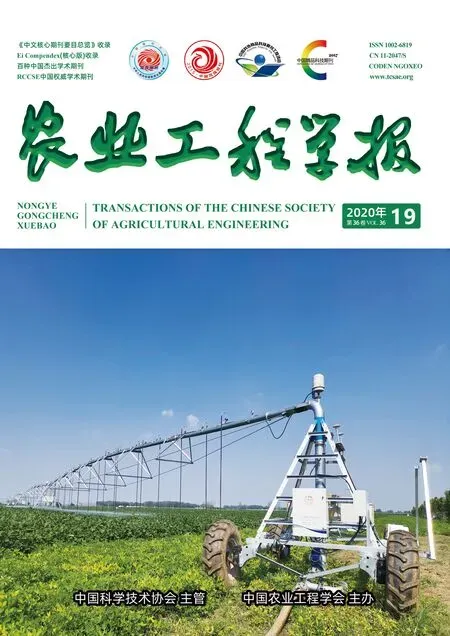水肥耦合对加气滴灌加工番茄产量及品质的影响
王振华,陈潇洁,吕德生,李文昊,王天宇,魏驰林
·农业水土工程·
水肥耦合对加气滴灌加工番茄产量及品质的影响
王振华1,2,陈潇洁1,2,吕德生1,李文昊1,2,王天宇1,2,魏驰林1,2
(1.石河子大学水利建筑工程学院,石河子 832000; 2.现代节水灌溉兵团重点实验室,石河子 832000)
为探求北疆地区水肥耦合对加气灌溉加工番茄产量、品质及水肥利用效率的影响,该研究设置2个灌溉水平分别为4 950和4 050 m3/hm2、4个施氮梯度分别为280、250、220和190 kg/hm2以及2个加气水平分别为掺气比例15%和0进行完全组合设计。结果表明,加气灌溉使加工番茄产量显著提高2.32%~10.02%,灌溉水分利用效率与氮肥偏生产力分别提高6.12%和6.19%。加气提高了加工番茄可溶性糖、有机酸、维生素C、可溶性固形物含量,基于主成分分析对各品质指标进行综合评价,得出最优处理为灌水4 050 m3/hm2,施氮250 kg/hm2。研究可为提高新疆加工番茄水肥利用率提供理论依据。
灌溉;土壤;品质控制;产量;加工番茄;加气灌溉;主成分分析
0 引 言
番茄(),含有丰富的抗氧化物质和维生素,是目前世界上种植最广的蔬菜作物之一。联合国粮农组织数据显示,2017年世界番茄总产量为1.8亿t[1]。中国番茄年产量高于5 000万t,是世界上加工番茄第三种植大国和番茄制品第一出口大国[2]。新疆维吾尔自治区(简称新疆)光热资源丰富、昼夜温差大有利于糖分累积,所产加工番茄产量高品质优,是中国重要的加工番茄生产基地[3]。
水肥利用效率低严重限制新疆加工番茄产业的发展。1996年新疆生产建设兵团引入膜下滴灌技术以来,膜下滴灌技术在新疆已应用24 a[4]。膜下滴灌将滴灌技术与覆膜种植技术结合,将灌溉水均匀地分配到土壤中,为作物提供适时适量的水分和养分,新疆种植加工番茄独特的优势资源结合膜下滴灌种植模式,使得新疆加工番茄在国际市场极具竞争力[5]。窦允清等[6]研究表明,膜下滴灌水肥一体化技术具有节水、节肥,提高作物产量和品质的优点。但地膜覆盖阻碍了土壤CO2的排放,破坏了土壤O2生产和扩散的动态平衡系统,改变了土壤的水热条件[7],加剧了作物根区缺氧的现象。植物根系需要足够的氧气来进行根系呼吸以及维持植物良好的新陈代谢功能[8]。番茄是对土壤氧气供应不足最敏感的作物之一,根区缺氧会影响根系生长和土壤呼吸,从而减少根系对水分和养分的吸收以及对植物体的营养传输[9]。
加气灌溉利用地下滴灌技术,通过加气设备将气体或者水气混合液随灌溉水输送至作物的根区,以满足作物根系有氧呼吸和土壤微生物对O2的需求[8]。Niu等[10]研究认为在番茄根区增氧有利于其根际气体环境的改善,使番茄根系活力和吸收能力增加。此外,加气灌溉显著增加了土壤微生物的丰度和酶活性[11],改善水肥吸收速率,有利于作物生长,提高产量和品质[12]。地下滴灌系统通过文丘里设备曝气有成本低、操作简单的优点,已被广泛应用于温室番茄、芹菜、棉花和辣椒。
新疆是中国最大的加工番茄生产基地,2017年加工番茄种植面积为59 000 hm2,产量为6 640 000 t[13],加工番茄生产能力占全国的90%以上[3]。然而,目前有关水肥气一体化灌溉研究较少,相关的研究也多集中在室内温室探究水气或水肥耦合对作物生长的影响[14-15],水肥气三因素耦合对新疆膜下滴灌加工番茄产量、品质及水肥利用的影响规律研究鲜见报道。因此本研究以提高新疆膜下滴灌加工番茄水肥利用效率为目标,通过水肥气三因素耦合试验探究水肥气一体化灌溉对新疆加工番茄产量和品质的影响,旨在为建立高产、高效节水的水肥气一体化灌溉模式提供理论依据和技术参考。
1 材料与方法
1.1 试验地概况
试验于2019年5-8月在新疆石河子大学现代节水灌溉兵团重点实验室暨石河子大学节水灌溉试验站(86°03′47″E,44°18′28″N)进行。试验站位于新疆生产建设兵团农八师石河子市西郊石河子大学农试场二连,海拔450 m,年均日照时数2 950 h,年降水量在220 mm左右。2019年加工番茄种植期间气象数据如图1所示。试验前茬种植作物为玉米,试验田地下水埋深8 m以下,土壤质地为中壤土,<0.01 mm粒径的土壤物理黏粒含量>21%,0~100 cm土壤年平均容重为1.56 g/cm3,田间持水率(即含水率)为17.98%。

图1 加工番茄生育期间气象数据
1.2 试验设计及试验材料
供试加工番茄品种为金番3166,购自石河子市143团十连农业科技园,试验于5月5日进行移苗定植,8月24日进行成熟期采获,全生育期112 d。种植模式为“1膜2管4行”,覆膜为1.45 m聚乙烯普通塑料地膜;定植前小区内预设直径16 mm,滴头间距0.3 m的2条以色列耐特菲姆滴灌带,滴灌带埋深15 cm,2条滴灌带间距0.85 m,滴头设计流量1.3 L/h,加工番茄种植株距0.35 m,行距0.3 m。
参考当地生产实践及其他学者研究[3,16],确定加工番茄种植的灌溉、施氮量以及灌溉、施肥次数(表1)。试验设W1(4 950 m3/hm2)和W2(4 050m3/hm2)2个灌溉水平,N1(280 kg/hm2)、N2(250 kg/hm2)、N3(220 kg/hm2)和N4(190 kg/hm2)4个施氮水平,A(加气灌溉,掺气比例15%)和C(不加气灌溉,掺气比例0)2个加气水平。共计16个处理,每个处理设置3个重复,试验小区面积为18.45 m2(9 m×2.05 m),磷肥和钾肥统一为150 kg/hm2。试验设计如表2所示。其中,试验肥料依次为尿素CO(NH2)2(N质量分数为46.4%),磷酸一铵NH4H2PO4(P2O5质量分数为60.5%)和氯化钾KCl(K2O质量分数为57%),试验小区的除草、打药等田间农艺管理措施一致。
滴灌加气施肥设备主要由蓄水池、水泵、文丘里管、回流管、施肥罐、旋翼式水表及输水管道系统组成。采用深层地下水进行灌溉,灌溉水矿化度约1.35 g/L。加气灌溉试验处理利用文丘里空气射流器(Mazzei air injector 1078,美国Mazzei Corp 公司)进行加气,Mazzei1078型文丘里空气射流器安装在滴灌系统首部,当水流经过文丘里射流器时,因涌流作用,横截面积变小流速上升,因而压力减小产生负压,吸入空气。通过水泵、文丘里空气射流器、回流管路实现循环曝气,制得掺气比例约为15%的掺气水[17]。灌溉时,通过调节回流管阀门,保证供水压力为0.1 MPa。每个小区均设置旋翼式水表及施肥罐。

表1 加工番茄生育期灌溉制度

表2 试验设计
1.3 项目测定与方法
1.3.1生长指标及灌溉水分利用效率
1)株高、茎粗测定:分别于苗期、花期、果实膨大一期、果实膨大二期、成熟期对加工番茄的株高、茎粗进行测量,每个小区随机选取3株进行标记,从植株基部用卷尺测量株高,用游标卡尺读取植株距离表层土2 cm处的茎粗,并取平均值。
2)灌溉水分利用效率(Irrigation Water-Use Efficiency,IWUE,kg/m3)的计算[18]如式(1)所示:
IWUE=/(1)
式中为相应处理加工番茄产量,kg/hm2;为相应处理灌水量,m3/hm2。
氮肥偏生产力(Nitrogen Partial Factor Productivity,PFPN,kg/kg)的计算[19]如式(2)所示:
PFPN=/(2)
式中为相应处理加工番茄产量,kg/hm2;为相应处理施氮量,kg/hm2。
1.3.2 产量及品质
1)产量测定:在加工番茄成熟期,每个小区选择6株长势均匀的植株测其产量,以单株计,包括单株产量、单果质量和果实数目的记录。
2)品质测定:加工番茄进入成熟收获期测定单果重使用BWS-SN-30电子计重桌秤(厦门佰伦斯品牌)并进行番茄品质的测定,用手持折射仪型号为MASTER-3M(日本爱宕品牌)测定可溶性固形物;采用蒽酮比色法测定可溶性糖含量;采用滴定法测定维生素C含量;采用碱滴定指示剂法测定有机酸含量[20]。
糖酸比(Suagr-acid ratio,SAT)的计算如式(3)所示:
SAT=/(3)
式中为加工番茄可溶性糖含量,%;为加工番茄有机酸含量,%。
1.4 数据分析
各主成分得分和综合得分的计算[21]如式(4)和式(5)所示
F=1i1+2i2+,…,UX(4)
=11+22+,…,+WF(5)
式中F为第主成分得分;1i,2i, …,U为第主成分的得分系数;X为标准化处理后的数值;表示主成分综合得分;W为第主成分权重,即各主成分因子的贡献率。
试验数据采用Microsoft Excel 2016进行计算,使用Origin 2017进行作图,SPSS Statistics 26进行方差分析和主成分分析。
2 结果与分析
2.1 水肥耦合对加气滴灌加工番茄生长的影响
2.1.1 株高
不同水肥气组合方案对滴灌加工番茄株高的影响如图2所示。随着时间的推移,不同水肥气处理下加工番茄株高呈现不同幅度的增长。移植后25~50 d,株高增幅最大,为0.819 cm/d。移植后50~75 d,加工番茄株高日增长量降低,此阶段加工番茄的营养生长主要集中在果实部位。移植后110 d,灌水量、施氮量和加气量对加工番茄株高影响达到极显著水平(<0.01),加工番茄株高随着灌水量、施氮量和加气量的增加而增加。W1水平较W2水平加工番茄株高增加10.43%,N1水平加工番茄株高较N2、N3和N4水平分别增加4.16%、6.90%和12.99%,加气处理较不加气处理加工番茄株高增加4.28%。2个灌水量水平下,与不加气处理相比,加气W1水平下加工番茄株高增加5.08%,加气W2水平下加工番茄株高增加3.41%,加气对高灌水量水平(W1)株高增长率提高更为明显。4个施氮量处理下,与不加气处理相比,加气N1、N2、N3和N4加工番茄株高分别增加了4.66%、4.99%、4.02%和3.39%,N2水平株高增长率最大。以上分析表明,充足的灌水施氮量,有助于加工番茄株高的增长,加气同样对加工番茄株高有促进作用。

注:W1和W2分别表示灌水量为4 950和4 050 (m3·hm-2);N1、N2、N3和N4分别表示施氮量为280、250、220和190 (kg·hm-2);A表示加气;C表示不加气。不同字母表示α=0.05水平下差异显著。下同。
2.1.2 茎粗
不同水肥气组合方案对滴灌加工番茄茎粗的影响如图3所示。
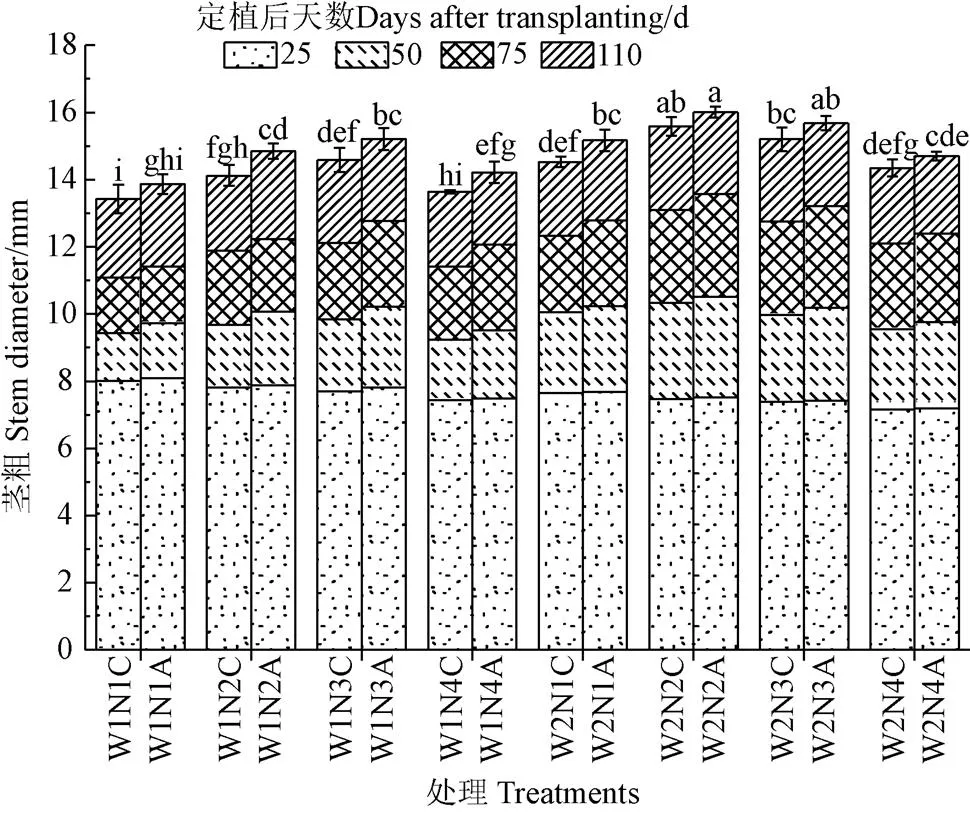
图3 不同水肥气处理对加工番茄生育期茎粗的影响
不同水肥气处理下加工番茄茎粗随着时间的推移,呈现不同幅度的增长。移植后25~50 d,W1水平下茎粗在N3达到最大,W2水平下茎粗在N2达到最大,且W2水平较W1水平加工番茄茎粗增加3.58%。移植后50~75 d,各处理茎粗增幅最大,为0.097 3 mm/d。移植后110 d,灌水量、施氮量和加气量对加工番茄茎粗影响达到极显著水平(<0.01),W2水平较W1水平加工番茄茎粗增加6.43%,灌水量增大反而使加工番茄茎秆变细。W1水平下,N3水平加工番茄茎粗较N1、N2和N4分别增加9.16%、2.85%和6.97%,W2水平下,N2水平加工番茄茎粗较N1、N3和N4分别增加6.37%、2.28%和8.73%,加气处理较不加气处理加工番茄茎粗增加3.70%。2个灌水量水平下,与不加气处理相比,加气W1水平下加工番茄茎粗增加4.24%,加气W2水平下加工番茄茎粗增加3.18%,加气对高灌水量水平(W1)茎粗增长率明显更大。
2.2 水肥耦合对加气滴灌加工番茄产量、灌溉水分利用效率和氮肥偏生产力的影响
不同水肥气组合方案对滴灌加工番茄产量、灌溉水分利用效率和氮肥偏生产力的影响如表3和表4所示。高灌水量提高了加工番茄产量,W1水平较W2水平产量显著增加2.18%~16.95%(<0.05)。相同灌水量下,随施氮量增加,加工番茄产量先增加后减小,即施氮量达到一定程度后,作物产量增幅减小。加气灌溉显著提高加工番茄产量2.32%~10.02%(<0.05),产量最大值出现在W1N2A处理,其次为W2N2A处理,处理间并无显著差异(>0.05)。与不加气处理相比,加气W1水平下产量增加了6.38%,W2水平下产量增加了5.89%;加气条件下N1、N2、N3和N4产量较不加气处理分别增加了3.50%、9.56%、4.92%和6.50%。结果表明在W2灌水量下,施氮量为N2时,加气处理对产量的提升最大。
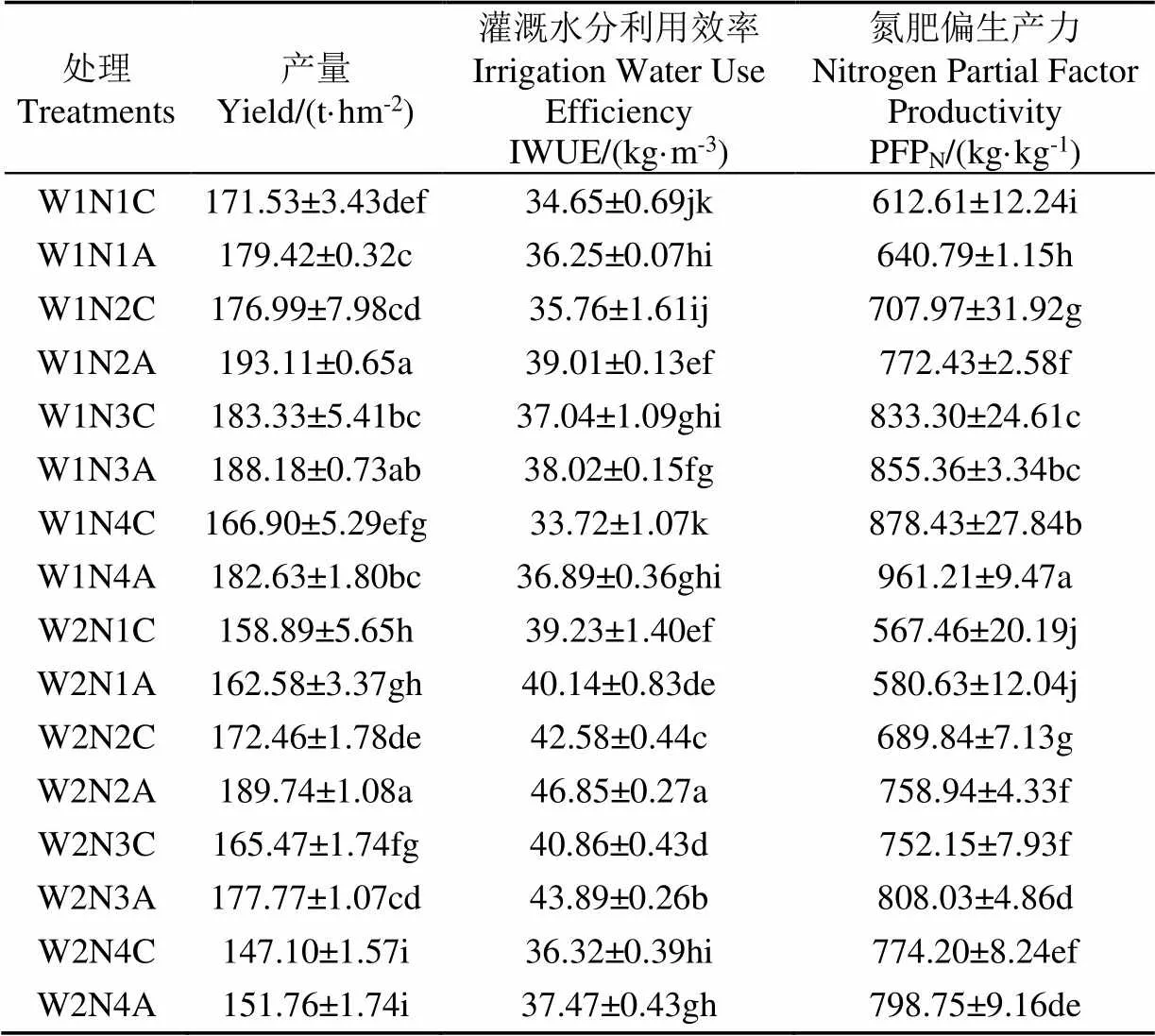
表3 水肥气耦合对加工番茄产量、灌溉水分利用效率和氮肥偏生产力的影响
注:同列数据不同小写字母表示=0.05水平存在显著性差异。下同。
Note: The different letters at same column indicated significant differences at the level of=0.05. The same blow.
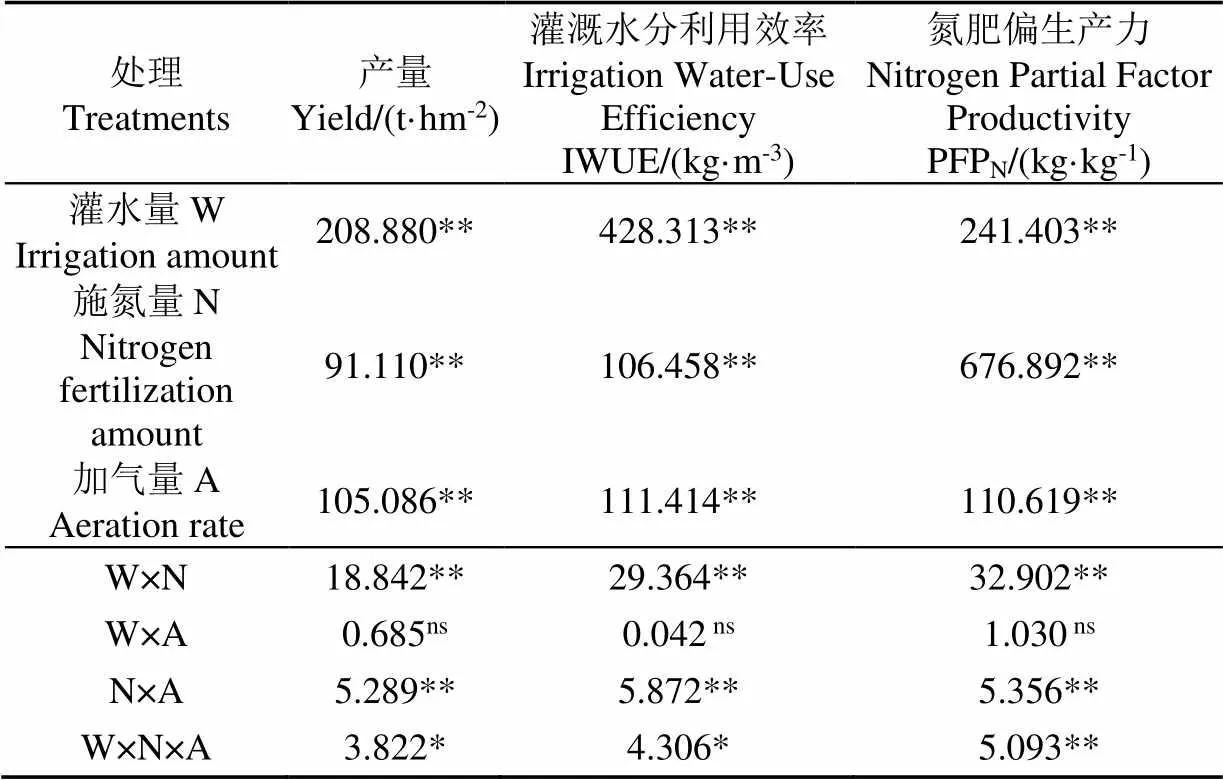
表4 水肥气对加工番茄产量、灌溉水分利用效率和氮肥偏生产力的三因素方差分析
注:*和**分别表示=0.05和=0.01水平存在显著性差异,ns表示=0.05水平不存在显著性差异。下同。
Note: * and ** indicated significant difference at=0.05 and=0.01 levels, respectively, ns indicated no significant difference at=0.05 level. The same below.
高灌水量使加工番茄IWUE减小,PFPN增大,W1水平较W2水平IWUE显著减小4.31%~16.40%(<0.05),PFPN显著增加2.18%~16.95%(<0.05)。相同灌水量下,随施氮量增加,IWUE先增加后减小,PFPN逐渐减小。加气处理较不加气处理IWUE和PFPN分别增加6.12%和6.19%。与不加气处理相比,加气W1水平下IWUE和PFPN分别增加6.38%和6.51%,加气W2水平下IWUE和PFPN分别增加5.89%和5.84%,4个施氮量水平中加气N2水平对IWUE和PFPN提升最大,分别为9.61%和9.55%。
2.3 水肥耦合对加气滴灌加工番茄果实品质的影响
不同水肥气组合方案对滴灌加工番茄品质的影响如表5和表6所示。
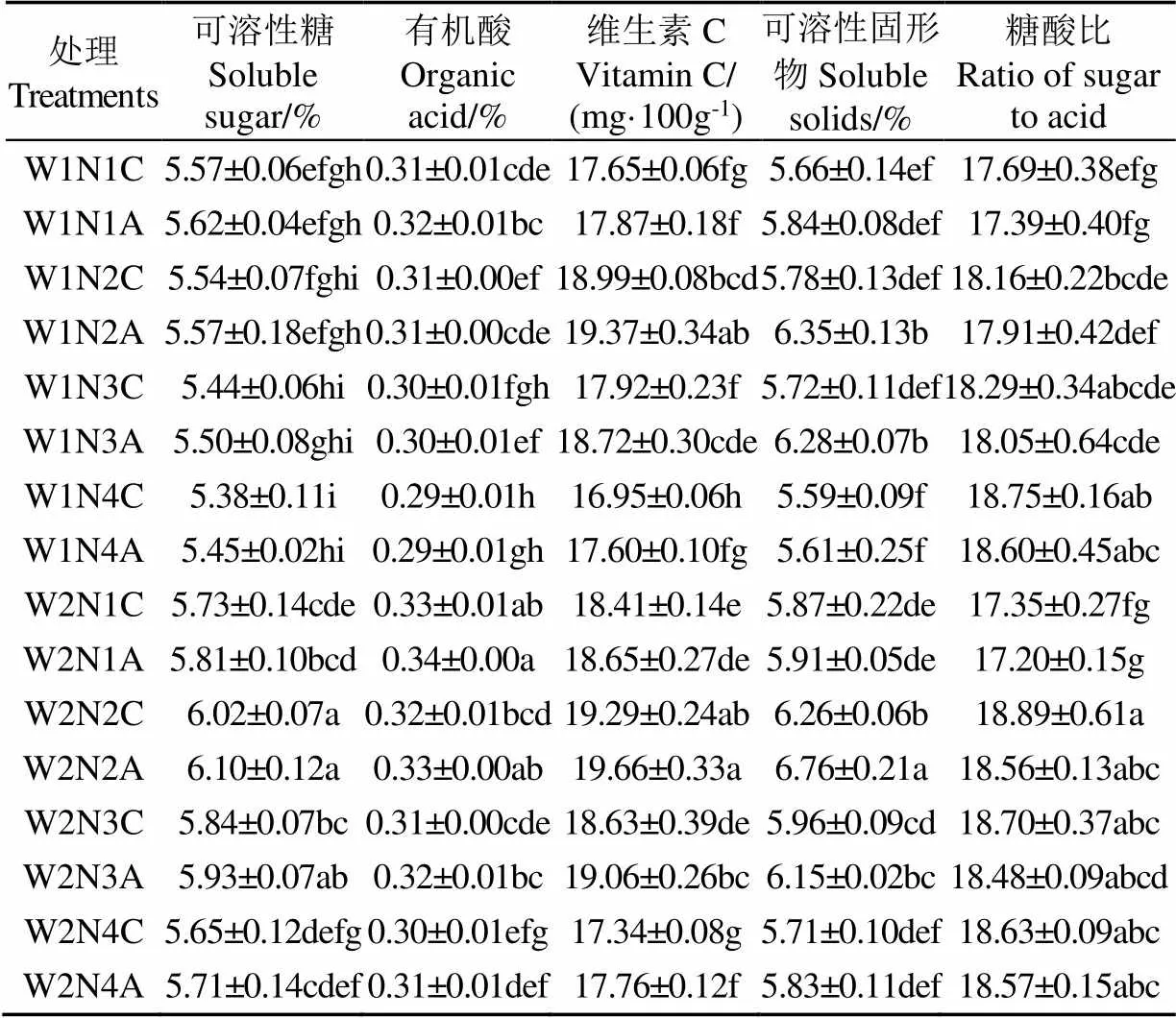
表5 水肥气耦合对加工番茄品质的影响

表6 水肥气对加工番茄品质的三因素方差分析
灌水量对加工番茄可溶性糖、有机酸、维生素C(Vitamin C,VC)和可溶性固形物产生极显著影响(<0.01)。W1水平较W2水平可溶性糖、有机酸、维生素C和可溶性固形物分别下降了5.84%、4.85%、2.50%和3.34%。可溶性糖、维生素C和可溶性固形物含量随着施氮量的增加呈现先增大后降低的趋势,W2N2A处理可溶性糖(6.10%)、维生素C(0.196 6 mg/g)和可溶性固形(6.76%)含量达到最大。有机酸含量随施氮量增加显著增大,N1处理较N4处理有机酸增加9.67%。加气对加工番茄各品质指标有显著影响(<0.05),与不加气灌溉处理相比,加气灌溉下可溶性糖、有机酸、维生素C和可溶性固形物含量分别增大了1.17%、2.37%、2.42%和4.68%。同时加气灌溉下加工番茄糖酸比含量显著降低(<0.05),比不加气灌溉降低了1.17%。
由于单独的一项番茄品质指标并不能全面反映其优劣,故需要对番茄各项指标进行综合分析及评价。主成分分析与评价法是一种多元统计方法,通过求解主成分,可以在少损失原有指标信息的情况下,实现减少变量个数与综合评价的目的,在许多领域的综合评价中被广泛应用[21]。选取评价变量分别为可溶性糖(1)、有机酸含量(2)、维生素C含量(3)、可溶性固形物(4)、糖酸比(5)5个品质指标,采用主成分分析法对5个品质指标进行降维数学统计分析,因子荷载和方差贡献率如表7所示。
经主成分分析提取前2个主成分的特征值>1,累计贡献率达到87.043%,说明前2个主成分包含了5个指标的大部分信息。因此用这2个主成分代替原来的5个指标对番茄品质进行评价。第一主成分解释了总变异信息的60.119%,主要反映维生素C(3)、可溶性糖(1)、可溶性固形物(4)、有机酸(2)4个指标的影响,第二主成分包含了原始信息的26.924%,主要以糖酸比(5)的影响为主。
结合式(4)和式(5),计算各主成分得分和综合得分,并按综合分值大小进行排序,结果如表8所示。其中,加工番茄品质最好的处理为W2N2A,品质最差的处理是W1N4C。不同的灌溉量处理下,W2的综合得分大于W1,过高的灌水量,不利于加工番茄综合品质的提高。在相同的灌水量处理下,不同施氮量作用下,加工番茄综合品质按大小顺序依次为N2、N3、N1和N4,过高、过低的施氮量,均不利于加工番茄综合品质的提高。加气处理提高了加工番茄品质,与不加气处理相比,加工番茄综合评价得分均有提高,在W1灌水量处理下,N2与N3施氮量处理综合得分提升最大。

表7 主成分因子荷载和方差贡献率

表8 不同处理加工番茄品质参数综合评价
3 讨 论
3.1 水肥耦合对加气滴灌加工番茄生长的影响
现代化灌溉不仅要求为作物生长提供适时、适量的水分和养分,更要营造水、肥、气、热相协调的土壤环境[22]。窦允清等[6]研究表明,膜下滴灌水肥一体化可以将作物所需的水分以及养分输送至作物根部土壤,根据作物不同生长阶段的需水需肥特性,为作物提供适时适量的水分和养分。本试验中,随着灌水量和施氮量的增加,加工番茄株高表现出逐渐增加趋势,过多的灌水量和施氮量则不利于植株茎粗的增加。适量施用氮肥能促进番茄根系活性及吸水能力[23],养分溶解水中通过质流或扩散达到根系表面,适量的水分有利于加快K+、H2PO4-等离子的扩散过程,促进植物吸收养分,促进植株生长[24]。过低的水肥施用量使得植物生长缓慢,茎秆和叶片营养不足,过量的水肥资源则会导致植物徒长,而使得茎秆变细[25]。
膜下滴灌技术特点是浅灌、勤灌、湿润范围小[4],灌溉期内土壤干湿交替频繁,土壤水分变化剧烈。Ming等[26]研究发现,灌溉使得土壤水分含量增加,但土壤呼吸呈下降趋势。较高的灌溉水平下,土壤水分过多,降低了土壤中氧气的扩散速率[27]。氧是细胞线粒体电子传递的最终受体,是有氧呼吸中合成腺嘌呤核苷三磷酸(Adenosine Triphosphate,ATP)的必要因素之一[28]。低氧胁迫下根际无氧呼吸增强,呼吸速率下降,产生的能量不足以维持正常生长,长期低氧胁迫下根细胞质膜过氧化程度加剧,根系活力下降,抑制植株生长[29]。在灌水过程中通入适量氧气,浅层土壤溶解氧浓度增大,改善了土壤中氧气扩散速率和氧化还原电位,能明显提高土壤通气性[30],缓解作物根际环境缺氧程度,提高根系总表面积及根系活跃吸收面积,显著提高根系活力[31]。刘义玲等[32]研究表明,根际低氧显著抑制作物生长,影响作物干物质累积,使得作物干物质量显著降低。朱艳等[12]研究发现,加气改善了灌溉后作物根系缺氧情况,番茄植株茎粗和叶面积分别显著增大4.55%和16.21%。本试验中,加气灌溉改善了灌溉后作物根系缺氧情况,显著提高加工番茄株高和茎粗,茎粗增大可以预防结果期植株倒伏,避免加工番茄减产,有利于番茄最终产量的增加。加气灌溉有效改善作物根际土壤通气性,提高了根系活力以及根系有氧呼吸,促进了根系对养分的吸收利用,叶片光合作用增强,进而促进植物生长。
3.2 水肥耦合对加气滴灌加工番茄产量和灌溉水分利用效率的影响
合理的肥料施用量、适宜的土壤含水量是保证作物高产的重要因素,本试验研究结果表明,增加灌溉量显著提高了番茄产量,增加了氮肥偏生产力,但降低了水分利用效率,这与邢英英等[33]研究的研究结果一致。番茄作为浅根作物,根系难以吸收深层水分和养分[34],姜慧敏等[35]研究表明随着施氮量的增加,土壤硝态氮累积量增加,高频灌溉下土壤氮素淋失加剧,造成土壤肥力下降。同时过量施氮常导致植株徒长,坐果率降低、抗逆性差,易于发生多种病害,最终影响番茄产量的形成,进而降低水分利用效率及氮肥偏生产力[25]。本试验结果表明适宜的施氮量可以显著提高番茄产量,过量的施氮量会降低产量,水分利用效率及氮肥偏生产力也显著降低。
番茄是对氧气胁迫相对敏感的作物,在田间种植中,常因为灌溉不当而使根部区发生氧气胁迫,致使其产量下降[9]。低氧胁迫情况下,根系以及微生物呼吸作用减弱,无氧呼吸酶活性提高,土壤微生物数量下降,作物呼吸作用以及生长发育表现异常,导致水分和养分利用效率下降[11]。大量试验研究表明,根区通气可以提高作物产量[8,12]。本试验中加气处理较不加气处理番茄产量显著增加了6.14%,灌溉水分利用效率及氮肥偏生产力显著提高了6.12%和6.19%。根区加气可提高根区土壤pH值,加速中部土层有机质分解,促进土壤速效磷、钾活化,促进作物对土壤中碱解氮、速效磷、钾的吸收[36],提高了作物根系活力,促进了对水肥的吸收利用。肖元松等[37]研究表明,增氧灌溉提高了植物根系总表面积及根系活跃吸收面积,增加根系全氮含量。加气改善土壤的通气状态,为土壤微生物及根系活动提供适宜氧气环境,显著提高了植物根系活力、根系硝酸还原酶、谷氨酰胺合成酶等氮代谢酶活性,进而叶片光合氮素利用率增加,有效促进植物的代谢和生长,促进植物对氮素的吸收[38],加强土壤硝化过程,减少氮素流失和提高氮素利用率[39]。
3.3 水肥耦合对加气滴灌加工番茄果实品质的影响
作物品质是衡量作物营养的重要指标,其含量高低决定作物的营养价值和口感,进而影响作物的商品价值。本试验研究表明,随着灌溉量的增加,加工番茄果实中可溶性糖、有机酸、维生素C、可溶性固形物等含量下降。这主要是增加灌水量对番茄各指标有稀释作用,增加灌水量,导致果实含水量增加,从而使品质指标含量稀释降低[40]。合理的施氮量可以提高可溶性糖、有机酸、维生素C、可溶性固形物含量,过多的施氮量会降低维生素C和可溶性固形物含量,这与汤明尧[41]研究结果一致。
根系长期缺氧导致根系对水分的传导性降低,加速叶绿素降解和降低光合酶活性,抑制植物光合作用,降低果实品质[42]。本研究表明,加气处理较不加气处理提高了可溶性糖、有机酸、维生素C、可溶性固形物含量,但降低了果实糖酸比,这与温改娟等[43]研究结果一致。霍建勇等[44]研究认为,番茄良好的风味,必须在较高的含糖量基础上有合适的糖酸比,即使有合适的糖酸比,糖酸均过低,也会影响番茄口感,因此糖酸比的变化受到可溶性糖和有机酸含量的影响,糖酸比的下降并不意味着番茄口感的下降。但加气灌溉下番茄维生素C含量的增大,却是番茄果实品质提高的表现[12]。本试验的维生素C含量增加显著(<0.05),说明根区加气改善了根际氧环境,保障了植株生理功能的正常运转,对果实品质有一定的提升作用。通过采用主成分分析法对5个品质指标进行降维数学统计分析,加工番茄品质最好的处理为W2N2A,适宜的灌水量和施氮量有利于加工番茄品质的提升,而加气灌溉可以在水肥耦合的基础上明显的提高加工番茄的果实品质。
4 结 论
本试验研究了水肥耦合对加气滴灌加工番茄产量、品质及灌溉水分利用效率的影响,得到以下结论:
1)灌水量增加提高加工番茄株高、产量和氮肥偏生产力,但减小了作物茎粗和灌溉水分利用效率;随着施氮量增加,加工番茄茎粗、产量和灌溉水分利用效率先增加后减小,氮肥偏生产力逐渐减小;与不加气处理相比,加气处理显著提高加工番茄株高和茎粗(<0.05),产量显著增加2.32%~10.02%(<0.05),灌溉水分利用效率和氮肥偏生产力分别显著提高6.12%和6.19%(<0.05)。
2)加工番茄可溶性糖、维生素C和可溶性固形物随着施氮量的增加先增加后降低,随灌水量的增加而减小;加气处理较不加气处理增加可溶性糖、有机酸、维生素C、可溶性固形物含量,但降低了果实糖酸比。
3)基于主成分分析,综合考虑作物株高、茎粗、产量、灌溉水分利用效率(Irrigation Water-Use Efficiency,IWUE)、氮肥偏生产力(Nitrogen Partial Factor Productivity,PFPN)及品质,研究认为加气处理下灌溉定额4 050 m3/hm2,施氮量250kg/hm2为较优的滴灌加工番茄水肥气管理模式。
[1] Sengar A S, Rawson A, Muthiah M, et al. Comparison of different ultrasound assisted extraction techniques for pectin from tomato processing waste[J/OL]. Ultrasonics Sonochemistry, 2020, 61. [2019-9-28]. https://doi.org/10.1016/j.ultsonch.2019.104812.
[2] 张桂芬,刘万学,万方浩,等. 世界毁灭性检疫害虫番茄潜叶蛾的生物生态学及危害与控制[J]. 生物安全学报,2018,27(3):155-163.
Zhang Guifen, Liu Wanxue, Wan Fanghao, et al. Bioecology, damage and management of the tomato leafminer(Meyrick) (Lepidoptera: Gelechiidae), a worldwide quarantine pest[J]. Journal of Biosafety, 2018, 27(3): 155-163. (in Chinese with English abstract)
[3] 杨玉珍,孟超然,张新疆,等. 氮、钾肥用量对膜下滴灌加工番茄产量和品质的影响[J]. 中国土壤与肥料,2017,54(1):61-67.
Yang Yuzhen, Meng Chaoran, Zhang Xinjiang, et al. Effect of nitrogen and potassium fertilizer on yield and quality of processing tomato under drip irrigation with plastic film mulching[J]. Soil and Fertilizer Sciences in China, 2017, 54(1): 61-67. (in Chinese with English abstract)
[4] 李明思,刘洪光,郑旭荣. 长期膜下滴灌农田土壤盐分时空变化[J]. 农业工程学报,2012,28(22):82-87.
Li Mingsi, Liu Hongguang, Zheng Xurong. Spatiotemporal variation for soil salinity of field land under long-term mulched drip irrigation[J]. Transactions of the Chinese Society of Agricultural Engineering (Transactions of the CSAE), 2012, 28(22): 82-87. (in Chinese with English abstract)
[5] 李青军,张炎,胡伟,等. 施肥方式对滴灌加工番茄干物质积累、养分吸收和产量的影响[J]. 中国土壤与肥料,2017(4):93-98.
Li Qingjun, Zhang Yan, Hu Wei, et al. Effects of fertilization on dry matter accumulation, nutrient uptake and yield of processing tomato under drip irrigation[J]. Soil and Fertilizer Sciences in China, 2017(4): 93-98. (in Chinese with English abstract)
[6] 窦允清,王振华,张金珠,等. 水肥耦合对滴灌加工番茄生理生长及产量的影响[J]. 江苏农业科学,2019,47(7):124-129.
Dou Yunqing, Wang Zhenhua, Zhang Jinzhu, et al. Effects of water and fertilizer coupling on physiological growth and yield of tomato under drip irrigation[J]. Jiangsu Agricultural Sciences, 2019, 47(7): 124-129. (in Chinese with English abstract)
[7] Li Zhiguo, Zhang Runhua, Wang Xiujun, et al. Carbon dioxide fluxes and concentrations in a cotton field in northwestern china: Effects of plastic mulching and drip irrigation[J]. Pedosphere, 2011, 21(2): 178-185.
[8] Bhattarai S P, Pendergast L, Midmore D J. Root aeration improves yield and water use efficiency of tomato in heavy clay and saline soils[J]. Scientia Horticulturae, 2006, 108(3): 278-288.
[9] Horchani F, Aschi-Smiti S, Brouquisse R. Involvement of nitrate reduction in the tolerance of tomato (L.) plants to prolonged root hypoxia[J]. Acta Physiologiae Plantarum, 2010, 32(6): 1113-1123.
[10] Niu Wenquan, Jia Zongxia, Zhang Xuan, et al. Effects of soil rhizosphere aeration on the root growth and water absorption of tomato[J]. Clean-Soil, Air, Water, 2012, 40(12): 1364-1371.
[11] Li Yuan, Niu Wenquan, Wang Jingwei, et al. Effects of artificial soil aeration volume and frequency on soil enzyme activity and microbial abundance when cultivating greenhouse tomato[J]. Soil Science Society of America Journal, 2016, 80(5): 1208-1221.
[12] 朱艳,蔡焕杰,宋利兵,等. 加气灌溉对番茄植株生长、产量和果实品质的影响[J]. 农业机械学报,2017,48(8):199-211.
Zhu Yan, Cai Huanjie, Song Libing, et al. Impacts of oxygation on plant growth, yield and fruit quality of tomato[J]. Transactions of the Chinese Society for Agricultural Machinery, 2017, 48(8): 199-211. (in Chinese with English abstract)
[13] 新疆维吾尔自治区统计局. 新疆统计年鉴[M]. 北京:中国统计出版社,2019.
[14] 李元,牛文全,许健,等. 加气滴灌提高大棚甜瓜品质及灌溉水分利用效率[J]. 农业工程学报,2016,32(1):147-154.
Li Yuan, Niu Wenquan, Xu Jian, et al. Aerated irrigation enhancing quality and irrigation water use efficiency of muskmelon in plastic greenhouse[J]. Transactions of the Chinese Society of Agricultural Engineering (Transactions of the CSAE), 2016, 32(1): 147-154. (in Chinese with English abstract)
[15] 李欢欢,刘浩,孙景生,等. 水肥耦合对温室番茄产量、水分利用效率和品质的影响[J]. 排灌机械工程学报,2018,36(9):886-891.
Li Huanhuan, Liu Hao, Sun Jingsheng, et al. Effects of water and fertilizer coupling on yield, water use efficiency and quality of tomato in greenhouse[J]. Journal of Drainage and Irrigation Machinery Engineering, 2018, 36(9): 886-891. (in Chinese with English abstract)
[16] 雷成霞,李文昊. 膜下滴灌水氮耦合对加工番茄耗水强度及氮素吸收分配的影响[J/OL]. 石河子大学学报:自然科学版,2020:1-8. [2020-6-14]. https://kns.cnki.net/kcms/ detail/65.1174.N.20200612.1140.004.html.
Lei Chengxia, Li Wenhao. Effects of water and nitrogen coupling under film drip irrigation on the water consumption intensity and nitrogen uptake and distribution of processing tomatoes[J]. Journal of Shihezi University: Natural Science Edition, 2020:1-8. [2020-6-14]. https://kns.cnki.net/kcms/ detail/65.1174.N.20200612.1140.004.html. (in Chinese with English abstract)
[17] 雷宏军,臧明,张振华,等. 循环曝气压力与活性剂浓度对滴灌带水气传输的影响[J]. 农业工程学报,2014,30(22):63-69.
Lei Hongjun, Zang Ming, Zhang Zhenhua, et al. Impact of working pressure and surfactant concentration on air-water transmission in drip irrigation tape under cycle aeration[J]. Transactions of the Chinese Society of Agricultural Engineering (Transactions of the CSAE), 2014, 30(22): 63-69. (in Chinese with English abstract)
[18] 王鹏勃,李建明,丁娟娟,等. 水肥耦合对温室袋培番茄品质、产量及水分利用效率的影响[J]. 中国农业科学,2015,48(2):314-323.
Wang Pengbo, Li Jianming, Ding Juanjuan, et al. Effect of water and fertilizer coupling on quality, yield and water use efficiency of tomato cultivated by organic substrate in bag[J]. Scientia Agricultura Sinica, 2015, 48(2): 314-323. (in Chinese with English abstract)
[19] 于飞,施卫明. 近10年中国大陆主要粮食作物氮肥利用率分析[J]. 土壤学报,2015,52(6):1311-1324.
Yu Fei, Shi Weiming. Nitrogen use efficiencies of major grain crops in china in recent 10 years[J]. Acta Pedologica Sinica, 2015, 52(6): 1311-1324. (in Chinese with English abstract)
[20] 魏守辉,肖雪梅,钟源,等. 日光温室不同时段补光对番茄果实品质及挥发性物质影响[J]. 农业工程学报,2020,36(8):188-196.
Wei Shouhui, Xiao Xuemei, Zhong Yuan, et al. Effects of supplemental illumination in different periods on the quality and volatile compounds of tomato fruit in solar greenhouse[J]. Transactions of the Chinese Society of Agricultural Engineering (Transactions of the CSAE), 2020, 36(8): 188-196. (in Chinese with English abstract)
[21] 王峰,杜太生,邱让建. 基于品质主成分分析的温室番茄亏缺灌溉制度[J]. 农业工程学报,2011,27(1):75-80.
Wang Feng, Du Taisheng, Qiu Rangjian. Deficit irrigation scheduling of greenhouse tomato based on quality principle component analysis[J]. Transactions of the Chinese Society of Agricultural Engineering (Transactions of the CSAE), 2011, 27(1): 75-80. (in Chinese with English abstract)
[22] 杨开静. 滴灌条件下马铃薯田间土壤水、气交互效应与调控机理研究[D]. 北京:中国农业大学,2017.
Yang Kaijing. Interaction and Regulation Mechanism of Soil Water and Gases in Potato Field under Drip Irrigation[D]. Beijing: China Agricultural University, 2017. (in Chinese with English abstract)
[23] 梁斌,王群艳,董静,等. 水氮管理对设施番茄根系生长的影响[J]. 环境科学研究,2019,32(4):677-682.
Liang Bin, Wang Qunyan, Dong Jing, et al. Effects of irrigation and nitrogen managements on root growth of tomato under greenhouse condition[J]. Research of Environmental Sciences, 2019, 32(4): 677-682. (in Chinese with English abstract)
[24] 梁运江,依艳丽,许广波,等. 水肥耦合效应的研究进展与展望[J]. 湖北农业科学,2006,45(3):385-388.
Liang Yunjiang, Yi Yanli, Xu Guangbo, et al. Research progress and prospect of coupling effect of water and fertilizer[J]. Hubei Agricultural Sciences, 2006, 45(3): 385-388. (in Chinese with English abstract)
[25] 王激清,刘社平. 施氮量对番茄生长发育和氮肥利用率的影响[J]. 河南农业科学,2015,44(2):94-97.
Wang Jiqing, Liu Sheping. Effects of nitrogen application rate on tomato growth and nitrogen use efficiency[J]. Journal of Henan Agricultural Sciences, 2015, 44(2): 94-97. (in Chinese with English abstract)
[26] Ming Guanghuni, Hu Hongchang, Tian Fuqiang, et al. Precipitation alters plastic film mulching impacts on soil respiration in an arid area of Northwest China[J]. Hydrology and Earth System Sciences, 2018, 22(5): 3075-3086.
[27] 赵旭,李天来,孙周平. 番茄基质通气栽培模式的效果[J]. 应用生态学报,2010,21(1):74-78.
Zhao Xu, Li Tianlai, Sun Zhouping. Effects of substrate aeration cultivation pattern on tomato growth[J]. Chinese Journal of Applied Ecology, 2010, 21(1): 74-78. (in Chinese with English abstract)
[28] 王文泉,张福锁. 高等植物厌氧适应的生理及分子机制[J]. 植物生理学通讯,2001,37(1):63-70.
Wang Wenquan, Zhang Fusuo. The physiological and molecular mechanism of adaptation to anaerobiosis in high plants[J]. Plant Physiology Communications, 2001, 37(1): 63-70. (in Chinese with English abstract)
[29] 徐春梅,陈丽萍,王丹英,等. 低氧胁迫对水稻幼苗根系功能和氮代谢相关酶活性的影响[J]. 中国农业科学,2016,49(8):1625-1634.
Xu Chunmei, Chen Liping, Wang Danying, et al. Effects of low oxygen stress on the root function and enzyme activities related to nitrogen metabolism in roots of rice seedlings[J]. Chinese Journal of Agricultural Sciences, 2016, 49(8): 1625-1634. (in Chinese with English abstract)
[30] 徐建新,臧明,雷宏军,等. 增氧灌溉对盆栽冬小麦生长及土壤通气性的影响[J]. 干旱地区农业研究,2019,37(4):16-25.
Xu Jianxin, Zang Ming, Lei Hongjun, el al. Impacts of oxygenated irrigation on potted winter wheat growth and soil aeration[J]. Agricultural Research in the Arid Areas, 2019, 37(4): 16-25. (in Chinese with English abstract)
[31] 胡德勇,廖健程,陈哲,等. 控制灌溉增氧对超级稻生理生化特性及水分利用效率的影响[J]. 排灌机械工程学报,2020,38(5):500-505.
Hu Deyong, Liao Jiancheng, Chen Zhe, et al. Effects of controlled irrigation and oxygenation on physiological and biochemical characteristics and water use efficiency of super rice[J].Journal of Drainage and Irrigation Machinery Engineering, 2020, 38(5): 500-505. (in Chinese with English abstract)
[32] 刘义玲,李天来,孙周平,等. 根际低氧胁迫对网纹甜瓜生长、根呼吸代谢及抗氧化酶活性的影响[J]. 应用生态学报,2010,21(6):1439-1445.
Liu Yiling, Li Tianlai, Sun Zhouping, et al. Impacts of root-zone hypoxia stress on musk-melon growth, its root respiratory metabolism, and antioxidative enzyme activities[J].Chinese Journal of Applied Ecology, 2010, 21(6): 1439-1445. (in Chinese with English abstract)
[33] 邢英英,张富仓,吴立峰,等. 基于番茄产量品质水肥利用效率确定适宜滴灌灌水施肥量[J]. 农业工程学报,2015,31(增刊1):110-121.
Xing Yingying, Zhang Fucang, Wu Lifeng, et al. Determination of optimal amount of irrigation and fertilizer under drip fertigated system based on tomato yield, quality, water and fertilizer use efficiency[J]. Transactions of the Chinese Society of Agricultural Engineering (Transactions of the CSAE), 2015, 31(Supp.1): 110-121. (in Chinese with English abstract)
[34] 张新燕,王浩翔,牛文全. 水氮供应对温室滴灌番茄水氮分布及利用效率的影响[J]. 农业工程学报,2020,36(9):106-115.
Zhang Xinyan, Wang Haoxiang, Niu Wenquan. Effects of water and N-fertilizer supplies on the distribution and use efficiency of water and nitrogen of drip-irrigated tomato in greenhouse[J]. Transactions of the Chinese Society of Agricultural Engineering (Transactions of the CSAE), 2020, 36(9): 106-115. (in Chinese with English abstract)
[35] 姜慧敏,张建峰,杨俊诚,等. 不同氮肥用量对设施番茄产量、品质和土壤硝态氮累积的影响[J]. 农业环境科学学报,2010,29(12):2338-2345.
Jiang Huimin, Zhang Jianfeng, Yang Juncheng, et al. Effects of different treatments of nitrogen fertilizer on yield, quality of tomato and soil NO3-N accumulation in vegetable-greenhouse[J]. Journal of Agro-Environment Science, 2010, 29(12): 2338-2345. (in Chinese with English abstract)
[36] 赵丰云,杨湘,董明明,等. 加气灌溉改善干旱区葡萄根际土壤化学特性及细菌群落结构[J]. 农业工程学报,2017,33(22):119-126.
Zhao Fengyun, Yang Xiang, Dong Mingming, el al. Aeration irrigation improving grape rhizosphere soil chemical properties and bacterial community structure in arid area[J]. Transactions of the Chinese Society of Agricultural Engineering (Transactions of the CSAE), 2017, 33(22): 119-126. (in Chinese with English abstract)
[37] 肖元松,彭福田,张亚飞,等. 增氧栽培对桃幼树根系构型及氮素代谢的影响[J]. 中国农业科学,2014,47(10):1995-2002.
Xiao Yuansong, Peng Futian, Zhang Yafei, et al. Effects of aeration cultivation on root architecture and nitrogen metabolism of young peach trees[J]. Chinese Journal of Agricultural Sciences, 2014, 47(10): 1995-2002. (in Chinese with English abstract)
[38] 徐春梅,王丹英,陈松,等. 增氧对水稻根系生长与氮代谢的影响[J]. 中国水稻科学,2012,26(3):320-324.
Xu Chunmei, Wang Danying, Chen Song, et al. Effects of aeration on root growth and nitrogen metabolism in rice[J]. Chinese Journal of Rice Science, 2012, 26(3): 320-324. (in Chinese with English abstract)
[39] Du Yadan, Niu Wenquan, Zhang Qian, et al. Effects of nitrogen on soil microbial abundance, enzyme activity, and nitrogen use efficiency in greenhouse celery under aerated irrigation[J]. Soil Ence Society of America Journal, 2018, 82(3): 606-613.
[40] 张延平,温祥珍,李亚灵,等. 水氮耦合对日光温室番茄干物质生产与分配的影响[J]. 华北农学报,2018,33(2):215-223.
Zhang Yanping, Wen Xiangzhen, Li Yaling, et al. Effects of water and nitrogen coupling on dry matter production and allocation of tomato in a solar greenhouse[J]. Acta Agriculturae Boreali-Sinica, 2018, 33(2): 215-223. (in Chinese with English abstract)
[41] 汤明尧. 施氮对加工番茄养分吸收、分配及产量品质的影响[D]. 乌鲁木齐:新疆农业大学,2009.
Tang Mingyao. Effect of Nitrogen Application on Absorption and Distribution of Nutrition and Yield-Quality on Processing Tomato[D]. Urumqi: Xinjiang Agricultural University, 2009. (in Chinese with English abstract)
[42] 刘义玲,李天来,孙周平,等. 根际低氧胁迫对网纹甜瓜光合作用、产量和品质的影响[J]. 园艺学报,2009,36(10):1465-1472.
Liu Yiling, Li Tianlai, Sun Zhouping, et al. Effects of root-zone hypoxia stress on the photosynthesis, yield and quality of muskmelon[J]. Acta Horticulturae Sinica, 2009, 36(10): 1465-1472. (in Chinese with English abstract)
[43] 温改娟,蔡焕杰,陈新明,等. 加气灌溉对温室番茄生长、产量及品质的影响[J]. 干旱地区农业研究,2014,32(3):83-87.
Wen Gaijuan, Cai Huanjie, Chen Xinming, et al. Impact of aerated subsurface irrigation to growth, yield and quality of greenhouse tomato[J]. Agricultural Research in the Arid Areas, 2014, 32(3): 83-87. (in Chinese with English abstract)
[44] 霍建勇,刘静,冯辉,等. 番茄果实风味品质研究进展[J]. 中国蔬菜,2005,1(2):34-36.
Huo Jianyong, Liu Jing, Feng Hui, et al. Reviews on flavor quality of tomato[J]. China Vegetables, 2005, 1(2): 34-36. (in Chinese with English abstract)
Effects of water and fertilizer coupling on the yield and quality of processing tomato under aerated drip irrigation
Wang Zhenhua1,2, Chen Xiaojie1,2, Lyu Desheng1, Li Wenhao1,2, Wang Tianyu1,2, Wei Chilin1,2
(1. College of Water Resources and Architectural Engineering, Shihezi University, Shihezi 832000, China; 2. Key Laboratory of Modern Water- Saving Irrigation of Xinjiang Production & Construction Group, Shihezi 832000, China)
Optimizing water andfertilization management is a critical component for maximizing cropproduction and water-fertilizer use efficiency. Aerated irrigation is widely recognized to improve soil aeration and water productivity. However, information about crop yield and quality of processing tomato responds to water-nitrogen-gas coupling remains unclear. To explore the effects of water and fertilizer coupling under aerated irrigation on yield, quality, and water-fertilizer use efficiency of processing tomato (), and to determine the optimal water-nitrogen rate for improving quality under aerated irrigation, a field experiment was conducted in 2019 at the Key Laboratory of Modern Water-Saving Irrigation of the Xinjiang Production and Construction Corps at Shihezi University in Xinjiang, China. Two irrigation levels (4 950 and 4 050 m3/hm2), four nitrogen levels (280, 250, 220, and 190 kg/hm2), and two aerated rates (15% and 0) were tested using a completely randomized design. A local processing tomato cultivar, Jinfan 3166, was selected transplanted on May 5thmanually and harvested on August 24th. Subsurface drip irrigation was adopted in this study. Air was injected into a drip line using Mazzei air injector (Mazzei air injector 1078, American), and the aerated rate was approximately 15%. Plant height, stem diameter, yield, water-use efficiency, nitrogen partial factor productivity, and fruit quality parameter of processing tomato were determined. The results showed that irrigation and nitrogen fertilization significantly affected plant height and stem diameter of processing tomato (<0.05). The plant height of processing tomato was greater as the irrigation and nitrogen level increased. However, excessive irrigation and fertilization had a major negative impact on stem diameter. Furthermore, Aerated irrigation enhanced plant height and stem diameter more under higher irrigation levels. Processing tomato yield was greater at a high irrigation level by 2.18% to 16.95% than that in the low irrigation level. Under the same irrigation amount, processing tomato yield increased firstly and then decreased relative to nitrogen levels. Compared to no aerated irrigation, aerated irrigation significantly increased processing tomato yield by 2.32% to 10.02% (<0.05). Compared to low irrigation amount, more irrigation amount significantly decreased irrigation water-use efficiency by 4.31% to 16.40% (<0.05), but increased nitrogen partial factor productivity by 2.18% to 16.95% (<0.05). Under the same irrigation amount, irrigation water-use efficiency first increased and then decreased with the increase of nitrogen levels, and nitrogen partial factor productivity showed a negative correlation with the nitrogen amount. Aerated irrigation enhanced irrigation water-use efficiency and nitrogen partial factor productivity by an average of 6.12% and 6.19%, respectively, comparing to no aerated irrigation. Water-nitrogen-gas coupling had a stronger effect on the quality index of the processing tomato. Compared to low irrigation level, the average soluble sugar, organic acid, Vitamin C, and the soluble solid content was 5.84%, 4.85%, 2.50%, and 3.34% smaller in high irrigation amount. And soluble sugar, Vitamin C, and soluble solid content increased firstly and then decreased with the increase of nitrogen application. Aerated irrigation increased soluble sugar, organic acid, Vitamin C, and soluble solid content of processing tomato significantly (<0.05). Meanwhile, compared to no-aerated irrigation, the ratio of sugar to acid was significantly lower by 1.17% in aerated irrigation (<0.05). The principal component analysis was applied to evaluate and compare the water and nitrogenfertilization management technology with the fruit quality parameter of processing tomato. Two components were extracted from the quality index matrix which the accumulative contribution rate was 87.043%. Based on the principal component analysis, the comprehensive rankings revealed the suitable irrigation amount was 4 050 m3/hm2and the suitable nitrogen amount was 250 kg/hm2under aerated irrigation conditions, which ranked first. Under this pattern, the irrigation water-use efficiency was 46.85 kg/m3,which was significantly higher than other treatments (<0.05). These results could provide theoretical support for improving water-fertilizer use efficiency of processing tomato in Xinjiang.
irrigation; soils; quality control; yield; processing tomato; aerated irrigation; principal component analysis
王振华,陈潇洁,吕德生,等. 水肥耦合对加气滴灌加工番茄产量及品质的影响[J]. 农业工程学报,2020,36(19):66-75.doi:10.11975/j.issn.1002-6819.2020.19.008 http://www.tcsae.org
Wang Zhenhua, Chen Xiaojie, Lyu Desheng, et al. Effects of water and fertilizer coupling on the yield and quality of processing tomato under aerated drip irrigation[J]. Transactions of the Chinese Society of Agricultural Engineering (Transactions of the CSAE), 2020, 36(19): 66-75. (in Chinese with English abstract) doi:10.11975/j.issn.1002-6819.2020.19.008 http://www.tcsae.org
2020-04-08
2020-05-18
国家重点研发计划“经济作物水肥一体化技术模式研究与应用”(2017YFD0201506);兵团科技创新团队项目(2019CB004);兵团节水灌溉试验计划项目(BTJSSY-201907);石河子大学国际科技合作推进计划项目(GJHZ201803)
王振华,博士,教授,主要从事干旱区节水灌溉理论与技术研究。Email: wzh2002027@163.com
10.11975/j.issn.1002-6819.2020.19.008
S641.2; S275.6
A
1002-6819(2020)-19-0066-10

